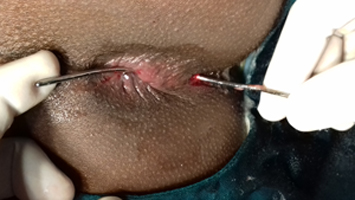
An anal fistula is a small tunnel that develops between the end of the bowel and the skin near the anus (where poo leaves the body). They're usually the result of an infection near the anus causing a collection of pus (abscess) in the nearby tissue. When the pus drains away, it can leave a small channel behind.
An anal fistula most often happens from an anal gland that has developed a pus-filled infection (abscess). A fistula can also happen with certain conditions such as Crohn's disease. Or it may happen after radiation therapy for cancer. Injury to the anal canal and surgery can also cause anal fistulas.
Although the gold standard technique to insert the ksharsutra is through an external opening by using a metallic probe to negotiate the fistulous tract as well as to find out the internal opening, we can use an infant feeding tube for inserting the ksharasutra. The patient is kept in a left lateral position in a private environment with a good source of light. Copious amount of 2% xylocaine jelly is applied over the external opening as well as over the entire infant feeding tube. A partial cut 1-2 cm distal to the tip of the infant feeding tube to make an indentation is made. Once an indentation is made at the insertion side of the infant feeding tube, this side of the tube is inserted through the external opening. The infant feeding tube is pushed passively and negotiated through the fistulous tract. The internal opening is finally located, and the tube is taken out through it using the index finger. Once the indented end of the infant feeding tube comes out through the internal opening, the ksharsutra is tied at the indentation (towards the internal opening) and then pulled through the other end. Finally, both ends of the ksharsutra are tied and the infant feeding tube removed. We can also insert a smaller size infant feeding tube by bending it in a folded manner. Once it comes out through the internal opening, the ksharsutra is tied at the bending end. In this way, we can insert the ksharsutra with the help of the infant feeding tube, causing minimal trauma and less agony to the patient.
Fistula tracts must be treated because they will not heal on their own. There is a risk of developing cancer in the fistula tract if left untreated for a long period of time.
Fistulas can cause a lot of discomfort, and if left untreated, may cause serious complications. Some fistulas can cause a bacteria infection, which may result in sepsis, a dangerous condition that can lead to low blood pressure, organ damage or even death.
Assess and document the type of fistula drainage. The odor, color, and consistency of drainage helps you determine the fistula's origin; this, in turn, allows you to design an appropriate pouching system. The drainage is liquid, and its green color indicates it's from the small intestine.
You can put a gauze pad over the opening of the fistula to absorb the drainage, if needed. Most people can go back to work and their normal routine 1 to 2 weeks after surgery. It will probably take several weeks to several months for your fistula to completely heal.